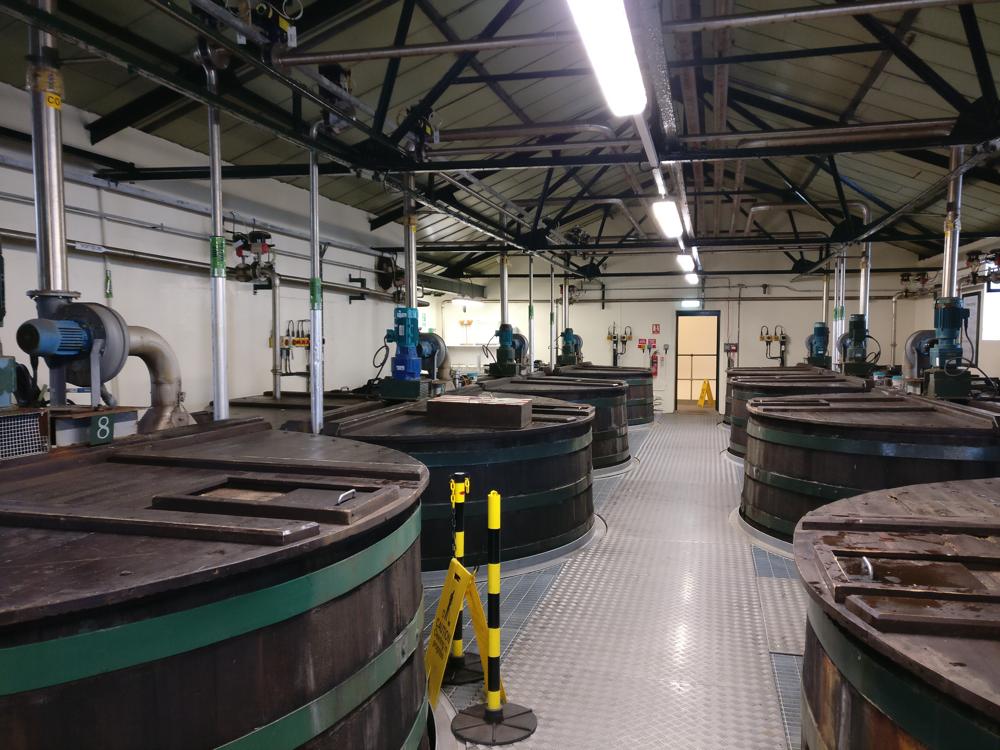TLDR
Washbacks
The fermentation containers used at distilleries, more commonly referred to as washbacks are a controversial topic among single malt drinkers. Particular concern has arrised in recent years over the use of stainless steel over the more traditional Douglas Fir/Oregon Pine containers used.The Long Read
Published September 2, 2020
Contents

What are Washbacks?
Washbacks or Fermentersare vessels made of wood, stainless steel , stoneware or concrete used for fermentation in connection with the production of alcohol. Within the whisky industry fermentation tanks are traditionally made of wood though a number of distilleries have followed the example of wine makers and breweries and begun shifting to stainless steel.
Concrete Washbacks
Famously, or perhaps infamously the Scottish Ben Nevis distillery was fitted with concrete washbacks under the tenure of former Canadian bootlegger Joseph William Hobbs. This was not actually the only distillery to adopt this practice however. Prior to its refurbishment in 1991 the now closed Karuizawa distillery also used epoxy-lined concrete washbacks.
Are Wooden Washbacks Better Than Steel?
No consensus has been reached on the subject but there are a number of arguements in favour of Wooden washbacks over stainless steel. So much so that Caol Ila owner Diageo have introduced a barcode system to differentiate between their wooden and stainless steel washbacks. The former are used for single malt, the latter can only be used for blending. There are two main differences between stainless steel and wooden washbacks:
- Heat Conduction
- Bacteria Growth
Heat Conduction
Metal is a natural heat conductor and the production of alcohol gives rise to considerable amounts of heat. As yeast breaks down sugar it creates three biproducts:
- Alcohol
- Carbon Dioxide (CO2)
- Heat The search for a better yeast is dictated by these three factors as each in turn is fatal to yeast. A high CO2 concentration is harmful to the growth and metabolism of Saccharomyces cerevisiae (distillers yeast), likewise the accumulation of alcohol becomes toxic and eventually kills the cells. Unfortunately the optimal temperature for yeast is 38°C/100°F, at 48°C/120°F the yeast will begin to die off.
The better heat insulation properties of wood give it a decided advantage in yeast longevity as opposed to stainless steel vats which must be cooled to prevent the yeast dying before sufficient alcohol has been extracted.
Bacteria Growth
The risk of bacteria growing in wooden washbacks is much higher than in stainless steel washbacks which are far easier to clean. This is a more nuanced consideration than it would appear however as a number of distilleries consider the flavour compounds created by these bacteria to be essential to the nature of their spirit.
Unlike brewers who need to exclude the funky, sour and sometimes sulphurous notes that can be created by bacteria in the beer distillers can be more laissez-faire about protecting their mashes from bacterial contamination as many of these flavour comppounds will either be stripped away by the act of distillation or through copper contact and the maturation process.
Douglas Fir versus Oregon Pine
Contrary to popular understanding Douglas Fir and Oregon Pine are not competing products but rather two names given to wood of the same tree, namely Pseudotsuga menziesii. The widely accepted Douglas fir name commemorates the nineteenth century Scottish botanist and collector David Douglas who identified plants in Oregon. His name is now attached to more than eighty species of plants and animals. Douglas fir can grow to 55m and live for more than 1,000 years
Other common names used for the Douglas-fir include:
- Oregon Pine
- British Columbian Pine
- Redfir
- Bigcone Douglas-fir
- Rocky Mountain Douglas-fir. Its botanical name, Pseudotsuga menziesii, commemorates Archibald Menzies, who discovered the tree in 1791.
Why Oregon Pine Used?
Andrew Brown manager of Bunnahabhain distillery tells us that “It is my understanding that Oregon pine was originally used as it was a tall, straight piece of wood that also had few knots in the length required”. As the washbacks are made of single straight pieces of wood, held together using only bands (they are in effect simply huge casks) the importance of the wood being straight, and relatively knot free is essential.
Ron Low, a 30-year veteran of Joseph Brown Vats of Dufftown, a specialty vat maker since 1921, tells us that the primary competitor to Oregon fir “Quality (European) larch is getting harder to source”
Does European Larch Produce Different Flavours to Oregon Pine?
While the exact difference is hard to identify Oregon Pine allows for greater build up of bacteria than European Larch. Stuart Robertson of Springbank opines that “larch has a tight grain and smooth surface, whereas Douglas Fir has a slightly more open grain and rougher surface. Therefore it stands to reason that even after sterilisation there could possibly be a higher bacterial count at the start of fermentation in the washback with a more open rough surface”.
Previous

